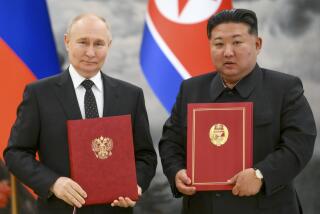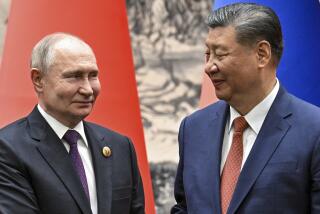GORBACHEV IN CHINA: The Communist Summit : The Big Sino-Soviet Thaw : Both nations stand to gain from a huge expansion of trade.
- Share via
BEIJING — Wang Zhaozhong sees a second golden age dawning for the Moscow Restaurant.
Soviet President Mikhail S. Gorbachev is in town, and promotion of Sino-Soviet trade and economic ties is on his agenda. Trade between the two neighbors is increasing rapidly--up 11-fold over the past decade--and growing numbers of Soviets are in the Chinese capital.
It seems like a good time for a Chinese to be in the business of serving Russian food.
Improved Sino-Soviet relations open prospects for cooperation that could put large numbers of Chinese laborers to work in Siberia, bring Soviet nuclear energy technology to China--and bring Russian cooks and a refurbished decor to the Moscow Restaurant.
Three decades after Russians last coached Chinese chefs at the Moscow Restaurant, several culinary experts from the Soviet capital arrived earlier this month to renew what Wang, the deputy manager, calls “a kind of friendly technical exchange.”
Plans are under way for long-term cooperation that is expected to turn the restaurant--the frequent scene of Soviet Embassy parties in the 1950s--into a Sino-Soviet joint venture.
In the glow of renewed friendship, prospects for Sino-Soviet endeavors go far beyond borsch and blinis.
“We need a new model for economic cooperation between our two countries,” Prof. Vladimir S. Myasnikov, deputy director of the Soviet Institute of Far Eastern Studies, said in an interview in Moscow. “This has to be worked out at the highest level. The economic potential is enormous, and the political implications are great too. . . . We think we have a lot to offer China’s modernization program, and we are certainly interested in their products.”
Trade under government-to-government agreements totaled $2.9 billion last year, with locally organized regional border trade and various types of direct economic links accounting for an additional value of about $385 million.
The trade under the annual government agreement is due to grow by nearly 20% this year, according to Eugene T. Bavrin, head of the Soviet trade office in Beijing, but the cross-border deals are likely to grow much faster and could even double.
China’s main exports to the Soviet Union include textiles, sports shoes, thermos flasks, soybeans, corn, meat, meat byproducts, fruit, handicrafts, machinery and tungsten ore.
Soviet shipments to China include steel products, nonferrous metals, timber, fertilizer, generators, mining equipment, cars, airplanes, locomotives and railway freight cars.
There is considerable room for this trade to expand. With central planning still playing a significant role in both economies--even as they also make room for market forces--annual trade plans offer some advantages to both sides.
Openings for Trade
Also, the economies of the two countries are largely complementary. The Soviet Union is interested in buying more Chinese consumer products--which may face growing protectionist barriers in Western markets--and it would like to boost exports of Siberian timber, fish, coal and ores. The logic of geography and the low population of Siberia dictates that these products can be highly competitive.
“China is just a river away from huge forests,” noted a Soviet economist in Moscow, who asked that his name not be used. “They don’t need to bring this from across the ocean, nor do they need to pay for it in dollars, because we will take their textiles, their electronic products, even their surplus rice.”
Most trade between China and the Soviet Union now goes through Manzhouli, a Chinese border town just east of Mongolia.
This situation may change in early 1991, however, when a railway now under construction in western Xinjiang province is due to link the two nations in a more direct east-west route already being called “the New Railway Silk Road.”
The Soviet Union is providing rails, ties, diesel fuel, excavators, trucks and machinery, some of it on credit, to assist in construction of the rail line. It is receiving Chinese foodstuffs, consumer goods and cotton in exchange.
Still a Small Fraction
Despite the rapid trade growth over the past decade in percentage terms, this still constitutes only a small fraction of each country’s total trade. For China, with 1988 trade of $69.2 billion, trade with the Soviet Union was less than 5% of the total. Sino-Soviet trade was an even smaller proportion of total Soviet trade--about 1.5% of the country’s $211-billion turnover last year.
Soviet leaders also have dramatic ideas for integrating eastern Siberia into the Pacific Rim economy, with Chinese labor playing a key role. If these visions prove feasible, an area that has long been among the most inaccessible in the world could take on a cosmopolitan air and become a major supplier of resources for East Asian economies.
Officials in Moscow envision trilateral projects combining Soviet raw materials, Chinese labor and Japanese, South Korean, Hong Kong or Singaporean capital and marketing skills.
Some Soviets describe the importance of this in dramatic terms.
“Our maritime region and the whole (Siberian) Far East are in really catastrophic shape economically, and our possibilities of developing them from the center are minimal,” Alexander Guber, an editor at the Soviet magazine New Times, said in an interview.
“If the Chinese are ready, we hope to develop economic relations, especially in the Far East, as a top priority,” Guber said. “We already have thousands of North Korean, Vietnamese and Chinese workers in the area, but we need 10, 20, even 30 times more. The Chinese are working especially well.”
Several Other Projects
Among the projects is a brickyard that Chinese workers from Suifenhe in Heilongjiang province are building across the Soviet border in the town of Pogranichni. Construction began in mid-1988, and production is to start in July, with an eventual output of 20 million bricks a year.
Other efforts involving Chinese labor in the Pogranichni region alone include a meat packing house, a sawmill, production of soft drinks, manufacture of consumer items ranging from thermoses to handkerchiefs and the cultivation of vegetables and melons.
The official New China News Agency has reported that about 10,000 Chinese laborers are expected to be working in Siberia by the end of this year. Smaller numbers of Chinese peasants are heading to work on farms in Soviet Central Asia.
The vision of such cooperation is not entirely new.
Chairman Mao Tse-tung proposed to Soviet leader Nikita S. Khrushchev in the mid-1950s that the two countries cooperate in joint projects, with Chinese peasants developing the “virgin lands” of Kazakhstan in Soviet Central Asia and Chinese workers building industries in Siberia.
But Khrushchev--envisioning millions of land-hungry Chinese who might never leave the Soviet Union once they came to work--rejected the proposal, Roy A. Medvedev, a Soviet historian, said in a recent interview.
Medvedev called it an “historical irony” that the two countries now “might look again at those projects, or ideas similar to them.”
Nuclear Industry
China now looks primarily to the West and Japan for technology transfer and investment. This orientation is unlikely to change, because Beijing has stable political and economic ties with these areas, which lead the world in industrial technology and the availability of investment capital.
But better Sino-Soviet ties will bring a greater Soviet role in China’s industrialization. Among the most dramatic possibilities is Soviet involvement in the development of China’s emerging nuclear energy industry.
The sale of Soviet reactors for a planned nuclear power plant in Liaoning province was a likely subject of discussion by Gorbachev in Beijing, according to a recent report in the Hong Kong Standard.
Anatoly Litiagin, Moscow’s deputy trade representative in Beijing, said in remarks reported by the Standard that the Liaoning deal is still in the primary stage of discussion.
“But I must say that the Soviet Union is very interested in helping China to develop its nuclear power industry,” Litiagin added.
While Soviet equipment often does not match the technological levels of the West, it can have its own competitive advantages of price and suitability.
Factories of 1950s
The Soviets are interested in re-equipping factories built with Soviet assistance in the 1950s. Soviet specialists say the Chinese have discovered that putting Japanese, West German or American machinery into Soviet-designed plants often does not work well.
The first Soviet loan to China in three decades is the equivalent of $125 million in credits for the purchase of Soviet equipment to renovate China’s Baotou Iron & Steel Works in Inner Mongolia.
China is also looking for Soviet help in agriculture and food processing.
Soviet funds and technology may be put to work in joint projects including chicken breeding, fish processing, soybean and coffee production and the repair in China of Soviet fishing ships, the official China Daily recently reported.
At the Moscow Restaurant, remodeling is due to impart a stronger Russian atmosphere to the main dining hall, while some side banquet halls will have the decor--and serve the specialties--of several Soviet minorities. Improved Sino-Soviet ties may also improve the food itself.
“Moscow’s mayor ate here with the mayor of Beijing, and he said most of the dishes were not bad, but that some didn’t have a real Russian flavor,” Wang said. A few cooks from Moscow--and a cooperative agreement ensuring better supplies of ingredients--are expected to solve the problem.
More to Read
Sign up for Essential California
The most important California stories and recommendations in your inbox every morning.
You may occasionally receive promotional content from the Los Angeles Times.













